A PhD student from Lancaster is looking for residents of the Western Isles who are willing to give an hour or so of their time to talk about the use of language. Α project is being run across the UK and Ireland about the difference between how older and younger people speak and how they feel about it.
If you are interested to participate, or know people who want to take part, please leave a brief note in comments. I'll relay the email address (which will show up in the comment notification) to the academic concerned, and you can then make arrangements direct. Confidentiality will be upheld by this blogger, and for anyone participating in the study.
Please relay.
Thank you.
Wednesday, 30 September 2009
Tuesday, 29 September 2009
Pairc buy-out
[caption id="" align="alignnone" width="500" caption="Habost, South Lochs, as seen from Keose"] [/caption]
[/caption]
When I arrived in this island in November 2004, I started off in South Lochs. At the time, there was a buzz of excitement in the air, with a vote on the 29th of that month on whether the community would bid to gain ownership of their land. The vote was in favour. The few hundred 'lochies' tried to set the wheels in motion to get the Pairc estate under their belt.
I am sad to report that this has so far proved unsuccessful. In my tenure of the Arnish Lighthouse blog, I have been very critical of local and indeed at times national (Scottish) politicians. I am not going to change that stance. I was pleased, in a way, to note that our MSP has finally woken up to the realisation that there was such a thing as a community buy-out bid in Pairc, and finally realised that there was an incredible amount of thwarting going on. Whilst I am very pleased that the Galson estate buy-out was successful, it was overlooked that theirs was NOT the oldest or the first buy-out in Lewis. Theirs was the first one to be successful.
The Pairc buy-out is mired in the deepest South Lochs bog for a couple of reasons. The main one, it would appear, is the way estate owner Barry Lomas is displaying his reluctance to part with his property. I can understand why - there are plans afoot to build a windfarm in South Lochs, which would generate a lot of £££. Mr Lomas is reported to be using the instrument of the interposed lease - leasing the land to another company (which he owns as well). Other reasons for the lack of success in Lochs is the difficulties in describing what the estate actually consists of. There is no definitive map. Instead, we have pinpoint accuracy in descriptions like: "stretching for 400 yards in a southwesterly direction from the Stornoway road". Furthermore, patches of land may be sublet, sub-sublet, and no trace of who is the main lessee. It is enough to make a stone weep.
Our MSP has finally remembered that the legislation which applies to community buy-outs does not just cater to the benign situation that the landowner willingly parts with his land. It also includes a clause for a hostile buy-out bid. I am still not holding my breath. I'll have to go through my files, if I can find the Pairc ones under that thick layer of dust and cobwebs, because I faintly remember something about a Land Court hearing that would take many moons to come to a ruling - back in July 2008.
The people in the Pairc Trust will hopefully have a more accurate and up to date status available, and hope that this will be forthcoming in local newsmedia in the very near future.
Postscript
I have just conducted a search on postings on this blog using the search term Pairc. Found at least 3 similar postings to the one I have written above, made in 2008, 2007 and 2006. Just goes to show how stuck this issue is. Let's hope the Environment Minister at Holyrood, who is responsible for buy-outs, will move things forward before the year is out.
 [/caption]
[/caption]When I arrived in this island in November 2004, I started off in South Lochs. At the time, there was a buzz of excitement in the air, with a vote on the 29th of that month on whether the community would bid to gain ownership of their land. The vote was in favour. The few hundred 'lochies' tried to set the wheels in motion to get the Pairc estate under their belt.
I am sad to report that this has so far proved unsuccessful. In my tenure of the Arnish Lighthouse blog, I have been very critical of local and indeed at times national (Scottish) politicians. I am not going to change that stance. I was pleased, in a way, to note that our MSP has finally woken up to the realisation that there was such a thing as a community buy-out bid in Pairc, and finally realised that there was an incredible amount of thwarting going on. Whilst I am very pleased that the Galson estate buy-out was successful, it was overlooked that theirs was NOT the oldest or the first buy-out in Lewis. Theirs was the first one to be successful.
The Pairc buy-out is mired in the deepest South Lochs bog for a couple of reasons. The main one, it would appear, is the way estate owner Barry Lomas is displaying his reluctance to part with his property. I can understand why - there are plans afoot to build a windfarm in South Lochs, which would generate a lot of £££. Mr Lomas is reported to be using the instrument of the interposed lease - leasing the land to another company (which he owns as well). Other reasons for the lack of success in Lochs is the difficulties in describing what the estate actually consists of. There is no definitive map. Instead, we have pinpoint accuracy in descriptions like: "stretching for 400 yards in a southwesterly direction from the Stornoway road". Furthermore, patches of land may be sublet, sub-sublet, and no trace of who is the main lessee. It is enough to make a stone weep.
Our MSP has finally remembered that the legislation which applies to community buy-outs does not just cater to the benign situation that the landowner willingly parts with his land. It also includes a clause for a hostile buy-out bid. I am still not holding my breath. I'll have to go through my files, if I can find the Pairc ones under that thick layer of dust and cobwebs, because I faintly remember something about a Land Court hearing that would take many moons to come to a ruling - back in July 2008.
The people in the Pairc Trust will hopefully have a more accurate and up to date status available, and hope that this will be forthcoming in local newsmedia in the very near future.
Postscript
I have just conducted a search on postings on this blog using the search term Pairc. Found at least 3 similar postings to the one I have written above, made in 2008, 2007 and 2006. Just goes to show how stuck this issue is. Let's hope the Environment Minister at Holyrood, who is responsible for buy-outs, will move things forward before the year is out.
Saturday, 26 September 2009
War and peace
I'm sure our Norwegian friends will forgive me for this title, which was inspired by this scene on Saturday morning.
[caption id="" align="alignnone" width="500" caption="Submarine S300 and cruiseliner tender from "Marco Polo""]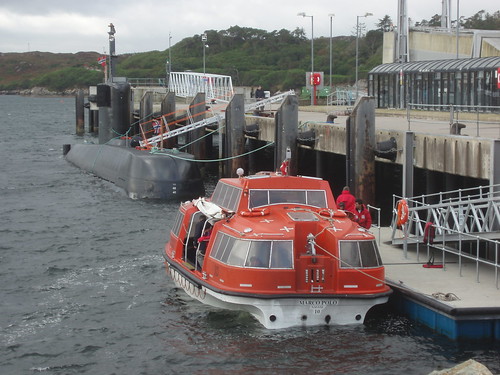 [/caption]
[/caption]
The Marco Polo left just after lunchtime, but the submarine appears to be attracting a lot of attention from the Saturday shoppers. Firmly tongue-in-cheek, it could be suggested that the sub is there to take people to the mainland on Sunday who do not want to be seen going on the ferry...
[caption id="" align="alignnone" width="500" caption="Submarine S300 and cruiseliner tender from "Marco Polo""]
 [/caption]
[/caption]The Marco Polo left just after lunchtime, but the submarine appears to be attracting a lot of attention from the Saturday shoppers. Firmly tongue-in-cheek, it could be suggested that the sub is there to take people to the mainland on Sunday who do not want to be seen going on the ferry...
Friday, 25 September 2009
Lewis & Harris in the 90s
[caption id="" align="alignnone" width="450" caption="Stornoway from no 1 pier, 25 July 1994"] [/caption]
[/caption]
[caption id="" align="alignnone" width="450" caption="View from the Ravenspoint Centre, Kershader, on 30 July 1996"]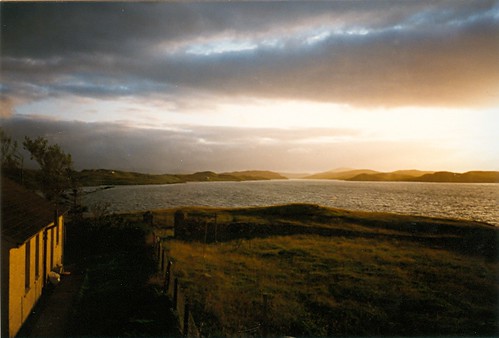 [/caption]
[/caption]
It is worth noting that the above view no longer exists. The (former) Storlann, Post Office and Croileagan presently stand in the centre / right of the picture, blocking the view down Loch Erisort.
[caption id="" align="alignnone" width="450" caption="Scaladale, 29 July 1996"]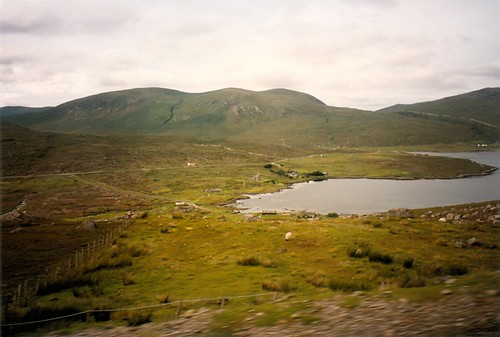 [/caption]
[/caption]
Ardvourlie Castle is still a ruin, and the Scaladale Centre does not yet exist.
[caption id="" align="alignnone" width="500" caption="Departing Stornoway, 31 July 1996"]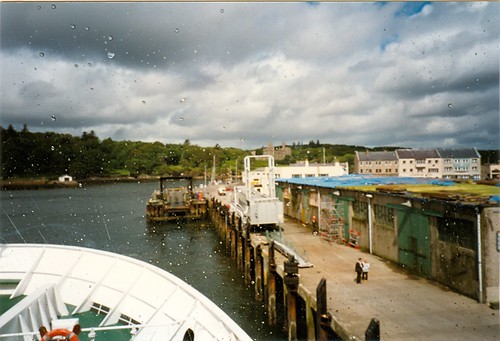 [/caption]
[/caption]
 [/caption]
[/caption][caption id="" align="alignnone" width="450" caption="View from the Ravenspoint Centre, Kershader, on 30 July 1996"]
 [/caption]
[/caption]It is worth noting that the above view no longer exists. The (former) Storlann, Post Office and Croileagan presently stand in the centre / right of the picture, blocking the view down Loch Erisort.
[caption id="" align="alignnone" width="450" caption="Scaladale, 29 July 1996"]
 [/caption]
[/caption]Ardvourlie Castle is still a ruin, and the Scaladale Centre does not yet exist.
[caption id="" align="alignnone" width="500" caption="Departing Stornoway, 31 July 1996"]
 [/caption]
[/caption]
Thursday, 24 September 2009
Busted buses
Scottish Citylink have advised their passengers to pre-book their seats, or run the risk of not being conveyed on their chosen service. This applies (of course) to the Ullapool to Inverness (and vice versa) service. Please note the date of this post: 24 September 2009.
On Friday 3 October 2008, I journeyed from Stornoway to Kirkwall, and this included the 55 miles bus trip from Ullapool to Inverness. On alighting from the MV Isle of Lewis at Ullapool in the morning, the busdriver was shouting at the top of his voice that only passengers with tickets would be allowed on board. Anyone without tickets had to wait until 5pm (7 hours later).This summer, the demand for travel to the Western Isles has been some 30% above that seen last year. Frought scenes have been played out at Inverness Bus Station, with people being left behind - with or without pre-booked tickets. Those with tickets were later conveyed to their destination by taxi, paid for by Citylink.
I am very displeased that it has taken Scottish Citylink TWELVE months to finally publicise their advice to the public in the Northwest Highlands.
On Friday 3 October 2008, I journeyed from Stornoway to Kirkwall, and this included the 55 miles bus trip from Ullapool to Inverness. On alighting from the MV Isle of Lewis at Ullapool in the morning, the busdriver was shouting at the top of his voice that only passengers with tickets would be allowed on board. Anyone without tickets had to wait until 5pm (7 hours later).This summer, the demand for travel to the Western Isles has been some 30% above that seen last year. Frought scenes have been played out at Inverness Bus Station, with people being left behind - with or without pre-booked tickets. Those with tickets were later conveyed to their destination by taxi, paid for by Citylink.
I am very displeased that it has taken Scottish Citylink TWELVE months to finally publicise their advice to the public in the Northwest Highlands.
Tuesday, 22 September 2009
Harris Tweed - my take
Tonight, the final programme in the series on Harris Tweed was aired on BBC4. The outlook remained at best a questionmark, and not much short of gloomy. Rather than get hot under the collar, I'll restrict myself to putting down the way I think the industry should move forward - a purely personal take, not unduly burdened by excess knowledge.
Harris Tweed is a product, unique to the Outer Hebrides, and therefore unique to Scotland. Its production, as laid down by the trademark description, has to take place in the Outer Hebrides - exclusively. This is such a narrow remit, that it merits intervention at Government level (Scottish Government) to take the industry in hand.
Brian Haggas's ownership of the Kenneth Mackenzie Mill in Stornoway should be bought out. He has a stock of men's jackets, which he is pandering off through newspaper competitions, saucy photoshoots and what not. At the rate he is going, it'll take nearly a decade to shift the 70,000 jackets that clog up his warehouse. The KM Mill's production capacity is needed, in conjunction with that of Shawbost and Carloway's mills, to make the volume, necessary to reinvigorate Harris Tweed. Rather than being in competition with each other, Stornoway, Shawbost and Carloway should work under an overseeing body which directs the work of the mills.
The BBC4 programme showed that there is demand for Harris Tweed. This should be channeled to be produced in the Outer Hebrides, using the abovementioned overseeing body. Who should this overseeing body consist of? Weavers as well as mills, combined with the Harris Tweed Authority. A cooperative? Well, I don't know enough about that sort of thing.
I'll repeat what I said at the end of my previous post on this subject. The Kenneth Mackenzie Mill in Stornoway is the keystone to Harris Tweed. Without this, the cloth will be relegated to handbags and seatcovers. And Brian Haggas's jackets.
Harris Tweed is a product, unique to the Outer Hebrides, and therefore unique to Scotland. Its production, as laid down by the trademark description, has to take place in the Outer Hebrides - exclusively. This is such a narrow remit, that it merits intervention at Government level (Scottish Government) to take the industry in hand.
Brian Haggas's ownership of the Kenneth Mackenzie Mill in Stornoway should be bought out. He has a stock of men's jackets, which he is pandering off through newspaper competitions, saucy photoshoots and what not. At the rate he is going, it'll take nearly a decade to shift the 70,000 jackets that clog up his warehouse. The KM Mill's production capacity is needed, in conjunction with that of Shawbost and Carloway's mills, to make the volume, necessary to reinvigorate Harris Tweed. Rather than being in competition with each other, Stornoway, Shawbost and Carloway should work under an overseeing body which directs the work of the mills.
The BBC4 programme showed that there is demand for Harris Tweed. This should be channeled to be produced in the Outer Hebrides, using the abovementioned overseeing body. Who should this overseeing body consist of? Weavers as well as mills, combined with the Harris Tweed Authority. A cooperative? Well, I don't know enough about that sort of thing.
I'll repeat what I said at the end of my previous post on this subject. The Kenneth Mackenzie Mill in Stornoway is the keystone to Harris Tweed. Without this, the cloth will be relegated to handbags and seatcovers. And Brian Haggas's jackets.
Friday, 18 September 2009
Harris War Memorial
The Harris War Memorial on-line, which was first published in August last year, has been extensively revised and updated with more information on many of the casualties. This contains listings for both World Wars, ordered by village. Any further information is more than welcome, in fact, desperately needed.
A Roll of Honour was never published for Harris for the First World War, leaving only the War Memorial at Tarbert for reference. Finding further information from the Commonwealth War Graves Commission (the primary source) can be very tricky and time-consuming in some instances.
All the main islands in the Western Isles now have their WW1 and WW2 casualties listed on line.
I would like to close this post by dedicating it to the memory of all the approximately 2,500 men from these islands who laid down their lives for King and Country during World Wars I and II.
A Roll of Honour was never published for Harris for the First World War, leaving only the War Memorial at Tarbert for reference. Finding further information from the Commonwealth War Graves Commission (the primary source) can be very tricky and time-consuming in some instances.
All the main islands in the Western Isles now have their WW1 and WW2 casualties listed on line.
I would like to close this post by dedicating it to the memory of all the approximately 2,500 men from these islands who laid down their lives for King and Country during World Wars I and II.
Thursday, 17 September 2009
Up and down
Contrary to my suspicions on Monday, the Uist rocket range was reprieved from closure. This means that 125 people in the Southern Isles will keep their jobs, and the threat to the upkeep of the St Kilda national reserve is removed. I fully back Scotland's First Minister Alex Salmond in his praise of the efforts of the Taskforce and others, thanks to whom the range will now remain open. Losing 125 jobs in a community of 5,000 would equate to losing 125,000 jobs across London - at a stroke.
BBC4 has been running a three-part documentary on the present plight of Harris Tweed. The 3rd instalment will be aired next Tuesday, 22 September, at 9pm. BBC4 is not available on terrestrial television; the episodes can be seen on BBC iPlayer - if you're in the UK. Apologies for the plugging of BBC services.
More to the point, it showed the fate of the Kenneth Mackenzie Harris Tweed Mill here in Stornoway, which was mothballed earlier this year, shedding all of its attendant jobs. Owner Brian Haggas had sought to convert it to a production unit for men's jackets made out of Harris Tweed, with 4 patterns. He utterly failed to grasp the idea behind Harris Tweed. And as a result, he as good as had to admit failure of his Stornoway enterprise.
Harris Tweed is still in demand, as the programme shows. However, with production capacity of tweed and yarn reduced drastically, it would require the re-opening of the KM mill in Stornoway. For that, it would probably be advisable for Mr Haggas to sell the plant, in order to cut his losses. If not, Harris Tweed is doomed to be reduced to handbags and seatcovers.
BBC4 has been running a three-part documentary on the present plight of Harris Tweed. The 3rd instalment will be aired next Tuesday, 22 September, at 9pm. BBC4 is not available on terrestrial television; the episodes can be seen on BBC iPlayer - if you're in the UK. Apologies for the plugging of BBC services.
More to the point, it showed the fate of the Kenneth Mackenzie Harris Tweed Mill here in Stornoway, which was mothballed earlier this year, shedding all of its attendant jobs. Owner Brian Haggas had sought to convert it to a production unit for men's jackets made out of Harris Tweed, with 4 patterns. He utterly failed to grasp the idea behind Harris Tweed. And as a result, he as good as had to admit failure of his Stornoway enterprise.
Harris Tweed is still in demand, as the programme shows. However, with production capacity of tweed and yarn reduced drastically, it would require the re-opening of the KM mill in Stornoway. For that, it would probably be advisable for Mr Haggas to sell the plant, in order to cut his losses. If not, Harris Tweed is doomed to be reduced to handbags and seatcovers.
Monday, 14 September 2009
Uist & Barra War Memorials
The information from the War Memorials for the islands of Berneray, North Uist, Benbecula, South Uist, Eriskay and Barra has been transferred to the Internet. Apart from the actual war memorials, pictured courtesy Scottish War Memorials Project, the cemeteries in the islands as well as the invaluable Commonwealth War Graves Commission website were all sources for further information. There are gaps, like there are in the information on Lewis casualties.
To reiterate: these are lists of the Fallen from both world wars. For the sake of clarity, there are separate pages for the First World War and for the Second World War.
[caption id="" align="alignnone" width="500" caption="Graveyard in Eriskay "]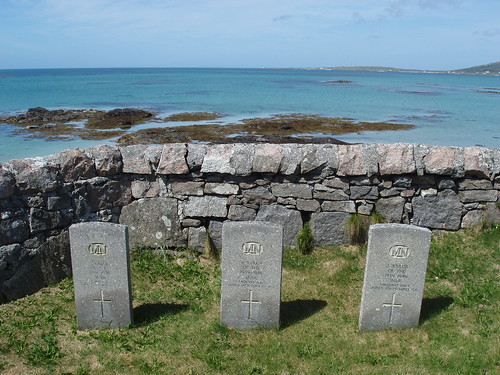 [/caption]
[/caption]
To reiterate: these are lists of the Fallen from both world wars. For the sake of clarity, there are separate pages for the First World War and for the Second World War.
[caption id="" align="alignnone" width="500" caption="Graveyard in Eriskay "]
 [/caption]
[/caption]
Cringeworthy
The operators of the Uist rocket range, QinetiQ, have posted a job-advert for a project manager to downsize said rocket range. This implies that a decision has already been taken for the range to be downgraded, even though the Ministry of Defense in London deny that.
QinetiQ call the recruitment drive prudent business practice. I call it something else. You do not advertise a job vacancy if it later turns out the job isn't going to be done. That could land you, as an employer, in seriously hot water. Although I find the efforts from our MSP to save the situation laudable, it is not the MSP that should be jumping up and down. Our MP, the man who represents us in Westminster, should be making a lot of noise over of this. For Defense is NOT a devolved issue, i.e. not something that the Scottish Government has any say over, and neither has the Scottish Parliament.
QinetiQ call the recruitment drive prudent business practice. I call it something else. You do not advertise a job vacancy if it later turns out the job isn't going to be done. That could land you, as an employer, in seriously hot water. Although I find the efforts from our MSP to save the situation laudable, it is not the MSP that should be jumping up and down. Our MP, the man who represents us in Westminster, should be making a lot of noise over of this. For Defense is NOT a devolved issue, i.e. not something that the Scottish Government has any say over, and neither has the Scottish Parliament.
Sunday, 13 September 2009
Renewable energy - II
So could renewable energy be the salvation of the Western Isles economy? The islands' economy is in a fragile state, and there is indeed the potential to make the Arnish Fabrication Yard a hub for production of wind turbine towers, Pelamis sea-snake units as well as possibly machinery for harnessing tidal energy. An effort is being made to keep the AFY open, but it is a stop-start affair.
It was interesting to see the gentle shift from shore-based to off-shore windfarms over the past five years. As indicated, shore-based windfarms are attracting ever more opposition due to the impact on scenery and quality of life for those living nearby. I maintain that although nobody is legally entitled to a view, it does constitute an amenity which serves to bring visitors to the Western Isles.
I realise it could be construed as a serious case of NIMBY'ism, but nobody wants a windfarm outside their backdoor, do they? So why not stick the things out at sea and it won't bother anybody. Ah, but that means that the community ashore misses out on the big pay-outs. Well, I keep having my severe doubts whether that really would happen (I mistrust big money, full stop, see what happened a year ago).
My vision would be for an off-shore windfarm, wave-energy generator and a tidal energy generator ashore.
The Pairc Trust, just nextdoor to Uncle Nick's turbine garden, also want to erect a number of turbines, on the moorland between Habost and Gravir. The turbines will also be 450 feet tall. I am a long-standing supporter to community ownership of land - I was a supporter of the Eigg buy-out in 1997. The efforts of the Pairc community are the oldest buy-out in the Isle of Lewis, but also the least successful. The Pairc laird, Barry Lomas, has frustrated their efforts by using the instrument of an interposed lease, letting land to another company. Oh, a company he himself owns. It is pretty obvious why he is going to these lengths: Mr Lomas wants the windfarm revenues all to himself. For the record, I have the same objections to the Pairc Windfarm that I have to the Eishken Windfarm.
It was interesting to see the gentle shift from shore-based to off-shore windfarms over the past five years. As indicated, shore-based windfarms are attracting ever more opposition due to the impact on scenery and quality of life for those living nearby. I maintain that although nobody is legally entitled to a view, it does constitute an amenity which serves to bring visitors to the Western Isles.
I realise it could be construed as a serious case of NIMBY'ism, but nobody wants a windfarm outside their backdoor, do they? So why not stick the things out at sea and it won't bother anybody. Ah, but that means that the community ashore misses out on the big pay-outs. Well, I keep having my severe doubts whether that really would happen (I mistrust big money, full stop, see what happened a year ago).
My vision would be for an off-shore windfarm, wave-energy generator and a tidal energy generator ashore.
The Pairc Trust, just nextdoor to Uncle Nick's turbine garden, also want to erect a number of turbines, on the moorland between Habost and Gravir. The turbines will also be 450 feet tall. I am a long-standing supporter to community ownership of land - I was a supporter of the Eigg buy-out in 1997. The efforts of the Pairc community are the oldest buy-out in the Isle of Lewis, but also the least successful. The Pairc laird, Barry Lomas, has frustrated their efforts by using the instrument of an interposed lease, letting land to another company. Oh, a company he himself owns. It is pretty obvious why he is going to these lengths: Mr Lomas wants the windfarm revenues all to himself. For the record, I have the same objections to the Pairc Windfarm that I have to the Eishken Windfarm.
Friday, 11 September 2009
Mingulay
Mingulay, one of the Barra Isles or Bishop's Isles, is currently unoccupied. The last permanent inhabitants left in 1912, leaving the island as a haven for wildlife and a place for grazing sheep. The reason I am flagging this up in passing came about through researching the First and Second World War roll of honour for Barra. One of the sons of Mingulay appears in the listings for WW1:
Seaman Roderick Gillies
Son of John and Flora Gillies, of Mingulay, Barra
Husband of Mary Macdougall Gillies, of Caolis, Vatersay, Barra, Inverness-shire.
Military unit: RNR, HMT Robert Smith
Service number: 3560B
Date of death: 20 July 1917, at the age of 35
Memorial: Portsmouth Naval Memorial, panel 27
Local memorial: Barra & Vatersay, Nask, Barra
[caption id="" align="alignnone" width="450" caption="Mingulay's former settlement, image courtesy isleofbarra.com"] [/caption]
[/caption]
Seaman Roderick Gillies
Son of John and Flora Gillies, of Mingulay, Barra
Husband of Mary Macdougall Gillies, of Caolis, Vatersay, Barra, Inverness-shire.
Military unit: RNR, HMT Robert Smith
Service number: 3560B
Date of death: 20 July 1917, at the age of 35
Memorial: Portsmouth Naval Memorial, panel 27
Local memorial: Barra & Vatersay, Nask, Barra
[caption id="" align="alignnone" width="450" caption="Mingulay's former settlement, image courtesy isleofbarra.com"]
 [/caption]
[/caption]
Renewable energy
My post on the Eishken Windfarm elicited a discussion on the merits of wind energy, particularly large-scale windfarms in Lewis. The outcome was a complete disagreement.
I think it won't do any harm to post my take on the deployment of sources of renewable energy in the Western Isles. Purely personal, not asking anyone to agree or disagree.
Last night, I watched an episode of the Coast programme, as broadcast on BBC in 2006. At the time, the North Lewis Windfarm was still in the planning stages. It served however as a timely reminder of what could have been between Port of Ness and Stornoway (via Bragar). And what could yet be on the Eishken hills. In this case, 33 turbines, each standing 450 feet tall. With associated road and electricity infrastructure. It should also be born in mind that Eishken once was the home of more than 30 villages and hamlets, strung along the shores of Loch Seaforth and west round to Loch Shell and Lemreway. These were cleared in the 1820s to make way for sheep, and there is no permanent habitation now. Rather than opening up the area for limited redevelopment, it is now going to be turned into an industrial wasteland.
The argument of the impact on the landscape is one that is being wielded right across Scotland. Homes built in the proximity of some windfarms, e.g. Ayrshire, have seen their value plummet. The noise impact is higher than some people would have us believe.
Wind energy also carries the disadvantage of being inconsistent. The Isle of Lewis has an average windspeed of 16 knots, 18 mph (force 5 on the Beaufort scale). We have a gale every week (again, on average), and flat calm on a regular basis as well. In other words, the output from a wind turbine is always variable. It cannot be wholly relied on, as the turbines may need to be stopped for high wind and do not operate without wind. Point I am making is that you need other sources of energy to supplement the output from wind turbines.
On a national scale, this has led to the suggestion we build more nuclear powerstations. However, as long as the issue of nuclear waste has not been resolved, I (personally) do not think it is wise to build new nuclear powerstations. At this time.
So what else have we got? Wind energy does have a role to play, but the large scale projects have too large an environmental impact - on-shore. Off-shore windfarms have far less of an impact (that I am aware of).
Wavepower, the Pelamis seasnake, has been developed, trialled and even built in Scotland - for use in Portugal. So why not deploy it off the coast of Scotland? The ocean is never still, swells will always come to our western shores. The Portuguese are certainly benefiting by it, and proposal were recently mooted for a similar project off Great Bernera.
Tidal power will be put to use at Shader over the next few years, and has been supplying Islay with power for nearly two decades now.
Solar power? Yes, even Scotland has daylight, and the sun shines more often than you would perhaps give it credit for. On a small scale, solar power is already being used in streetlamps in the Lochs area of Lewis. A hundred miles south of here, in the Isle of Eigg, solar power also contributes to the energy requirements of its 86-strong population.
The above three sources all have as an advantage over large-scale windfarms that their environmental impact is a lot less. I do realise that the above mentioned sources of renewable energy may not suffice to meet the energy requirements for the whole of Scotland. However, for the small scale needs of the Western Isles, they most certainly can. If the political will is there, a profusion of schemes across Scotland could certainly make an impact nationwide.
I think it won't do any harm to post my take on the deployment of sources of renewable energy in the Western Isles. Purely personal, not asking anyone to agree or disagree.
Last night, I watched an episode of the Coast programme, as broadcast on BBC in 2006. At the time, the North Lewis Windfarm was still in the planning stages. It served however as a timely reminder of what could have been between Port of Ness and Stornoway (via Bragar). And what could yet be on the Eishken hills. In this case, 33 turbines, each standing 450 feet tall. With associated road and electricity infrastructure. It should also be born in mind that Eishken once was the home of more than 30 villages and hamlets, strung along the shores of Loch Seaforth and west round to Loch Shell and Lemreway. These were cleared in the 1820s to make way for sheep, and there is no permanent habitation now. Rather than opening up the area for limited redevelopment, it is now going to be turned into an industrial wasteland.
The argument of the impact on the landscape is one that is being wielded right across Scotland. Homes built in the proximity of some windfarms, e.g. Ayrshire, have seen their value plummet. The noise impact is higher than some people would have us believe.
Wind energy also carries the disadvantage of being inconsistent. The Isle of Lewis has an average windspeed of 16 knots, 18 mph (force 5 on the Beaufort scale). We have a gale every week (again, on average), and flat calm on a regular basis as well. In other words, the output from a wind turbine is always variable. It cannot be wholly relied on, as the turbines may need to be stopped for high wind and do not operate without wind. Point I am making is that you need other sources of energy to supplement the output from wind turbines.
On a national scale, this has led to the suggestion we build more nuclear powerstations. However, as long as the issue of nuclear waste has not been resolved, I (personally) do not think it is wise to build new nuclear powerstations. At this time.
So what else have we got? Wind energy does have a role to play, but the large scale projects have too large an environmental impact - on-shore. Off-shore windfarms have far less of an impact (that I am aware of).
Wavepower, the Pelamis seasnake, has been developed, trialled and even built in Scotland - for use in Portugal. So why not deploy it off the coast of Scotland? The ocean is never still, swells will always come to our western shores. The Portuguese are certainly benefiting by it, and proposal were recently mooted for a similar project off Great Bernera.
Tidal power will be put to use at Shader over the next few years, and has been supplying Islay with power for nearly two decades now.
Solar power? Yes, even Scotland has daylight, and the sun shines more often than you would perhaps give it credit for. On a small scale, solar power is already being used in streetlamps in the Lochs area of Lewis. A hundred miles south of here, in the Isle of Eigg, solar power also contributes to the energy requirements of its 86-strong population.
The above three sources all have as an advantage over large-scale windfarms that their environmental impact is a lot less. I do realise that the above mentioned sources of renewable energy may not suffice to meet the energy requirements for the whole of Scotland. However, for the small scale needs of the Western Isles, they most certainly can. If the political will is there, a profusion of schemes across Scotland could certainly make an impact nationwide.
Thursday, 10 September 2009
North Lochs
The eastern part of the island of Lewis, south of Stornoway, is referred to as Lochs. For obvious reasons. Driving down the minor sideroad to Grimshader, Ranish and Crossbost, you encounter nothing but lochs (Scots for lakes). The sea is never far away either, with several sealochs (obviously connected to the sea, in this case the Minch) penetrating deep inland. Loch Erisort, 10 miles south of Stornoway, reaches 15 miles from the sea to the village of Balallan. These are the site for several fish and musselfarms. Setting the scene for a scenic drive this afternoon, with the sun out.
Coming down the B897 (which branches off the main road south from Stornoway to Tarbert), first popped into Ranish, which overlooks Grimshader on the far side of the loch. Incidentally, the sideroad within Ranish takes you to the Loch Erisort side of the peninsula. It is fronted by a 360 foot high hill, which I once traversed in pouring rain, in my footloose days back in 2005. Beinn Mhor - to the Gaelic speakers among you, this name will not come as a surprise. The big hill. Doubling back into Crossbost, the road plunges down to the little bay at the end of the road. The churchyard, at the Leurbost side of the village, has seen me several times for war graves business.
Then continued through Leurbost to the junction at Cameron Terrace, then on to Achmore. The Pentland Road branch cuts the distance to town from 12 to 9 miles, although it is by no means faster. It rises to 500 feet above sealevel at Beinn a'Bhuinne, past shieling huts and peat banks. Pity that my camera battery gave out at that point, after sustaining me through about 250 pictures. Here are some of the 50 I took today.
[caption id="" align="alignnone" width="500" caption="Loch Roisgeil, between Grimshader and Ranish"] [/caption]
[/caption]
[caption id="" align="alignnone" width="500" caption="Fidigarry, Loch Grimshader, at Ranish"] [/caption]
[/caption]
[caption id="" align="alignnone" width="500" caption="Shack above Loch Grimshader, Ranish"]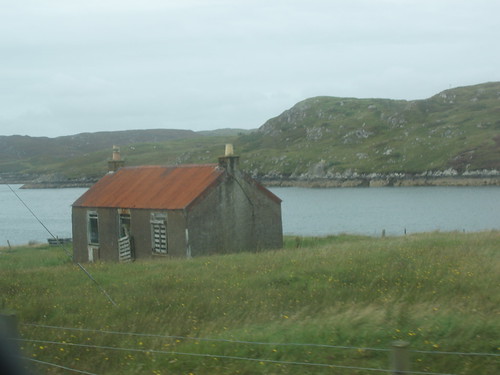 [/caption]
[/caption]
[caption id="" align="alignnone" width="500" caption="Ranish"] [/caption]
[/caption]
[caption id="" align="alignnone" width="500" caption="Loch Erisort at Crossbost"]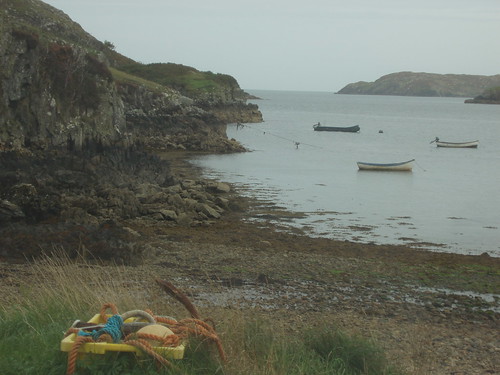 [/caption]
[/caption]
[caption id="" align="alignnone" width="500" caption="Leurbost"]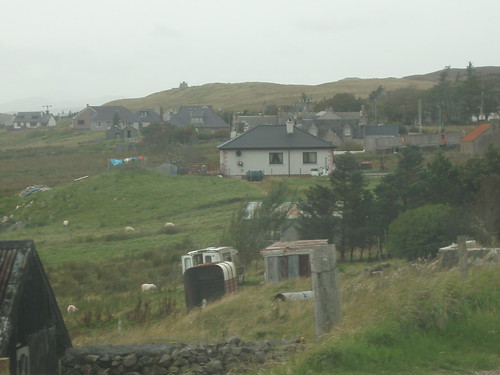 [/caption]
[/caption]
[caption id="" align="alignnone" width="500" caption="Lochs at Achmore"]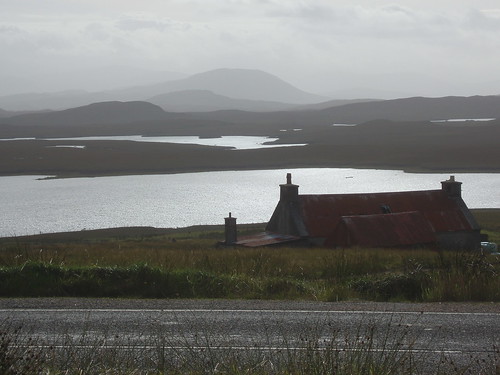 [/caption]
[/caption]
[caption id="" align="alignnone" width="500" caption="Achmore"]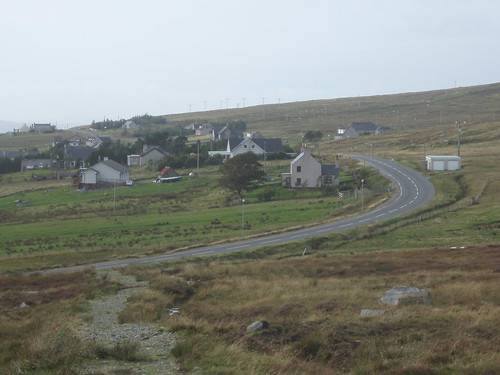 [/caption]
[/caption]
[caption id="" align="alignnone" width="500" caption="Shieling hut at Beinn a'Bhuinne, north of Achmore"]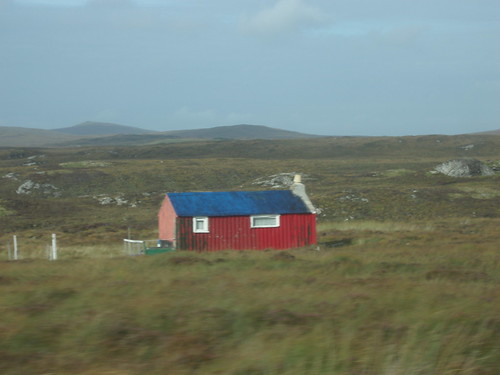 [/caption]
[/caption]
Coming down the B897 (which branches off the main road south from Stornoway to Tarbert), first popped into Ranish, which overlooks Grimshader on the far side of the loch. Incidentally, the sideroad within Ranish takes you to the Loch Erisort side of the peninsula. It is fronted by a 360 foot high hill, which I once traversed in pouring rain, in my footloose days back in 2005. Beinn Mhor - to the Gaelic speakers among you, this name will not come as a surprise. The big hill. Doubling back into Crossbost, the road plunges down to the little bay at the end of the road. The churchyard, at the Leurbost side of the village, has seen me several times for war graves business.
Then continued through Leurbost to the junction at Cameron Terrace, then on to Achmore. The Pentland Road branch cuts the distance to town from 12 to 9 miles, although it is by no means faster. It rises to 500 feet above sealevel at Beinn a'Bhuinne, past shieling huts and peat banks. Pity that my camera battery gave out at that point, after sustaining me through about 250 pictures. Here are some of the 50 I took today.
[caption id="" align="alignnone" width="500" caption="Loch Roisgeil, between Grimshader and Ranish"]
 [/caption]
[/caption][caption id="" align="alignnone" width="500" caption="Fidigarry, Loch Grimshader, at Ranish"]
 [/caption]
[/caption][caption id="" align="alignnone" width="500" caption="Shack above Loch Grimshader, Ranish"]
 [/caption]
[/caption][caption id="" align="alignnone" width="500" caption="Ranish"]
 [/caption]
[/caption][caption id="" align="alignnone" width="500" caption="Loch Erisort at Crossbost"]
 [/caption]
[/caption][caption id="" align="alignnone" width="500" caption="Leurbost"]
 [/caption]
[/caption][caption id="" align="alignnone" width="500" caption="Lochs at Achmore"]
 [/caption]
[/caption][caption id="" align="alignnone" width="500" caption="Achmore"]
 [/caption]
[/caption][caption id="" align="alignnone" width="500" caption="Shieling hut at Beinn a'Bhuinne, north of Achmore"]
 [/caption]
[/caption]
Monday, 7 September 2009
East coast foray
This afternoon, I went on an expedition for the eastern reaches of Lewis (and Harris) by car. First port of call was the tiny village of Keose, tucked away 2 miles off the main road between Stornoway and Tarbert.
[caption id="" align="alignnone" width="500" caption="Keose Harbour"]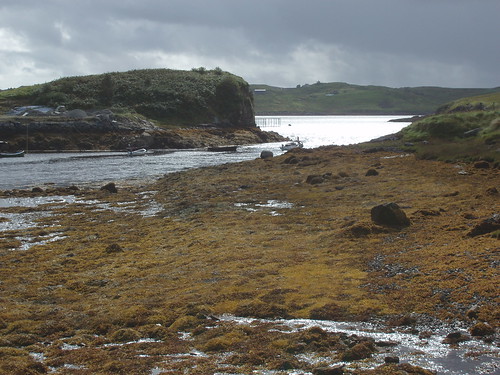 [/caption]
[/caption]
After freeing a small bird, that had managed to get itself locked into a creel, we had a look round and returned to the main road. Lunch was taken at the Loch Erisort Inn, in the shape of fish and chips. This used to be operated as the Claitair Hotel (still on the beer sign), but was refurbished a few years ago. The Loch Erisort Inn stands in the district of South Lochs, which I know very well after staying there through the winter of 2004/5. Nothing has changed round there.
[caption id="" align="alignnone" width="500" caption="Kinloch Seaforth"]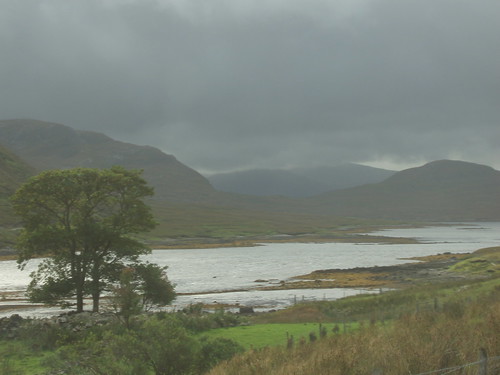 [/caption]
[/caption]
On up another side road, to Eishken. If only to see it whilst there are no wind turbines on the hills. It is a wild and desolate area, with a savage natural beauty. Its native inhabitants were removed to make way for sheep. I think the year 1820 is still referred to as the Year of the Sheep. Eishken Lodge is the base for shooters and fishers who go round the empty peninsula, which once hosted 36 villages. Back on the main road, I found a new memorial to that disaster of Scottish history called Bonnie Prince Charlie.
[caption id="" align="alignnone" width="500" caption="Monument for Bonnie Prince Charlie at Arivruaich"]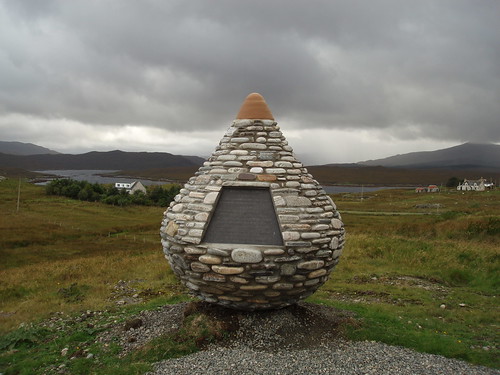 [/caption]
[/caption]
He had landed at Arivruaich (according to the memorial, although my info says it was on an island near Lemreway, 20 miles to the east) and sneaked over to Kildun Cottage at Arnish (just across the water from my current position) to request sanctuary in Stornoway. The burghers declined this hot potato but didn't shop BPC either.
[caption id="" align="alignnone" width="500" caption="Low clouds on the Clisham Pass"]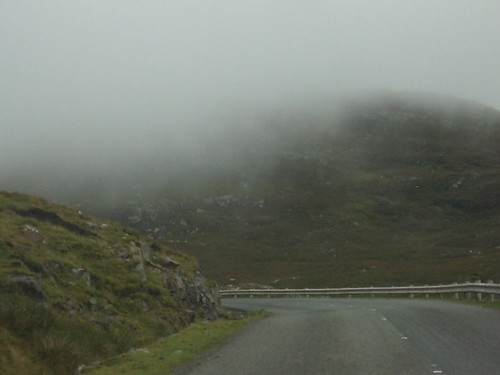 [/caption]
[/caption]
Crossed the border into Harris and promptly drove into the clouds (at 500 feet above sealevel) on our way to Rhenigidale. This village didn't have a road until 1987 - everything had to be brought in by boat or on foot. The main village in Harris, Tarbert, is 4 miles away, but that involves an ascent of 1,000 feet along a 1 in 2 incline. Upon return to Stornoway, I found I had taken 192 pictures today.
[caption id="" align="alignnone" width="500" caption="Maaruig from the Rhenigidale road"]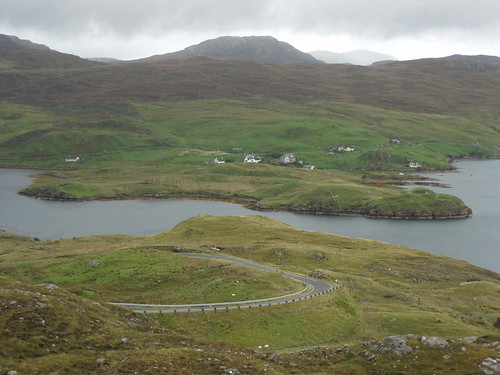 [/caption]
[/caption]
[caption id="" align="alignnone" width="500" caption="Keose Harbour"]
 [/caption]
[/caption]After freeing a small bird, that had managed to get itself locked into a creel, we had a look round and returned to the main road. Lunch was taken at the Loch Erisort Inn, in the shape of fish and chips. This used to be operated as the Claitair Hotel (still on the beer sign), but was refurbished a few years ago. The Loch Erisort Inn stands in the district of South Lochs, which I know very well after staying there through the winter of 2004/5. Nothing has changed round there.
[caption id="" align="alignnone" width="500" caption="Kinloch Seaforth"]
 [/caption]
[/caption]On up another side road, to Eishken. If only to see it whilst there are no wind turbines on the hills. It is a wild and desolate area, with a savage natural beauty. Its native inhabitants were removed to make way for sheep. I think the year 1820 is still referred to as the Year of the Sheep. Eishken Lodge is the base for shooters and fishers who go round the empty peninsula, which once hosted 36 villages. Back on the main road, I found a new memorial to that disaster of Scottish history called Bonnie Prince Charlie.
[caption id="" align="alignnone" width="500" caption="Monument for Bonnie Prince Charlie at Arivruaich"]
 [/caption]
[/caption]He had landed at Arivruaich (according to the memorial, although my info says it was on an island near Lemreway, 20 miles to the east) and sneaked over to Kildun Cottage at Arnish (just across the water from my current position) to request sanctuary in Stornoway. The burghers declined this hot potato but didn't shop BPC either.
[caption id="" align="alignnone" width="500" caption="Low clouds on the Clisham Pass"]
 [/caption]
[/caption]Crossed the border into Harris and promptly drove into the clouds (at 500 feet above sealevel) on our way to Rhenigidale. This village didn't have a road until 1987 - everything had to be brought in by boat or on foot. The main village in Harris, Tarbert, is 4 miles away, but that involves an ascent of 1,000 feet along a 1 in 2 incline. Upon return to Stornoway, I found I had taken 192 pictures today.
[caption id="" align="alignnone" width="500" caption="Maaruig from the Rhenigidale road"]
 [/caption]
[/caption]
Friday, 4 September 2009
Eishken Windfarm
The Eishken Windfarm has been approved by Comhairle nan Eilean Siar, without debate and by rubberstamp. What is really shocking is the so-called community element in the proposals, which have been swallowed by our local authority without question.
The few hundred souls in the Lochs area are expected to cough up some twenty-five million pounds in order to benefit from the turbines, allocated to them. It was not a free gift, it will require that mind-boggling sum. How on earth an economically fragile area like Lochs is going to generate that amount of capital defies even my rich imagination.
It is one thing that the developer has wreathed this aspect in mist until quite recently. It is a dereliction of duty on the part of our elected representatives for not questioning or properly scrutinise the proposals on at least that aspect. As I feared, the planning application was passed on the nod, as the Comhairle has this fixation with shore-based windfarms, dating back to 2004. They will have their windfarm, even if it means financial ruin for their own constituents. At this time of economic recession, any promise of jobs, however meagre, will act as a lure for the unsuspecting local authority. It is breathtaking that the Comhairle has fallen for it. They have even gone so far as to request an upgrade to the interconnector (the subsea electricity cable) to the mainland. The way our local authority has handled the planning process should be the object of censure. The developer kept changing and changing the proposals, reacting to objections. No fewer than four versions of the planning application were rubberstamped by the local authority. It should have scuttled the entire project before now.
There are a few points left at which this whole project could be jettisoned. The Scottish Government is to give final approval. The windfarm can only be built if the Beauly to Denny electricity transmission link is upgraded, which is far from certain due to fierce opposition in the Highlands. The same applies to the link between Dundonnell and Beauly.
Not since the resolution of the crisis in the Western Isles Health Board in 2007 has the Arnish Lighthouse blog expressed its dismay at a local issue in such strong terms. But should the Eishken Windfarm ever come to be built, it can safely be said that the Comhairle has sold us down the river.
The few hundred souls in the Lochs area are expected to cough up some twenty-five million pounds in order to benefit from the turbines, allocated to them. It was not a free gift, it will require that mind-boggling sum. How on earth an economically fragile area like Lochs is going to generate that amount of capital defies even my rich imagination.
It is one thing that the developer has wreathed this aspect in mist until quite recently. It is a dereliction of duty on the part of our elected representatives for not questioning or properly scrutinise the proposals on at least that aspect. As I feared, the planning application was passed on the nod, as the Comhairle has this fixation with shore-based windfarms, dating back to 2004. They will have their windfarm, even if it means financial ruin for their own constituents. At this time of economic recession, any promise of jobs, however meagre, will act as a lure for the unsuspecting local authority. It is breathtaking that the Comhairle has fallen for it. They have even gone so far as to request an upgrade to the interconnector (the subsea electricity cable) to the mainland. The way our local authority has handled the planning process should be the object of censure. The developer kept changing and changing the proposals, reacting to objections. No fewer than four versions of the planning application were rubberstamped by the local authority. It should have scuttled the entire project before now.
There are a few points left at which this whole project could be jettisoned. The Scottish Government is to give final approval. The windfarm can only be built if the Beauly to Denny electricity transmission link is upgraded, which is far from certain due to fierce opposition in the Highlands. The same applies to the link between Dundonnell and Beauly.
Not since the resolution of the crisis in the Western Isles Health Board in 2007 has the Arnish Lighthouse blog expressed its dismay at a local issue in such strong terms. But should the Eishken Windfarm ever come to be built, it can safely be said that the Comhairle has sold us down the river.
Tuesday, 1 September 2009
Remembering

Today is the 70th anniversary of the invasion of Poland, a military campaign that sparked off the Second World War. In the 6 years following, many thousands would lay down their lives in the defense of freedom. The Western Isles, once more, stood in the breach and supplied dozens of its young men to the services between 1939 and 1945. The death toll makes for sobering reading - having just transcribed the war memorials for all of the islands in the Western Isles (courtesy the Scottish War Memorials Project).
Lewis - 448
Harris - 58
North Uist & Berneray - 36
Benbecula - 6
South Uist & Eriskay - 51
Barra - 54
Total: 653
Lest we forget.
Subscribe to:
Posts (Atom)